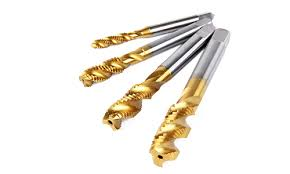Tapping is a machining process used in manufacturing to create internal threads within a hole to enable screws or bolts to be fastened securely. It is an important operation in the production of many mechanical parts and assemblies so that the components can be joined together with precision and stability.

The tapping process
Before tapping, a hole is drilled into the material to a specific size, slightly smaller than the desired thread’s major diameter. This hole, known as the pilot hole, provides the path for the tap to follow.
Taps, which are specialised cutting tools made from high-speed steel or carbide, are designed to cut threads inside the drilled hole. There are different types of taps, including hand taps, machine taps, and spiral point taps, each suited to various applications and materials.
The tap is inserted into the drilled hole and rotated, either manually or with a machine, to cut the threads. As the tap progresses, it removes material from the inside of the hole, forming the helical thread pattern. Lubrication is often applied to reduce friction and heat.
Companies such as cotswold-machinery-sales.co.uk/roscamat-tapping-machines offer a range of tapping arms for Roscamat tapping machines and machines from other manufacturers.
Let’s take a look at four types of taps:
Spiral point taps
Spiral point taps, also known as gun taps, are used for through-holes. Their design helps push chips ahead of the tap, preventing clogging and reducing the risk of tap breakage.

Spiral flute taps
Spiral flute taps are used for blind holes and work well with materials that produce long, stringy chips. The spiral design helps evacuate chips from the hole, improving the tapping process.
Forming taps
A forming tap creates internal threads by deforming the material rather than cutting it, making it ideal for aluminium and soft steels. This process produces stronger threads with a smooth surface finish and increased thread strength.
Straight flute taps
A straight flute tap is a basic type of cutting tap with flutes that run straight along the length of the tool. It is used for threading through-holes.


